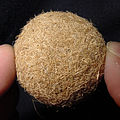
Sea balls (also known as Aegagropila or Pillae marinae) are tightly packed balls of fibrous marine material, recorded from the seashore. They vary in size but are generally up to 7 centimetres (2.8 in) in size. In Edgartown, Massachusetts a longish sea ball around 45 centimetres (18 in) in diameter has been found. Others have been reported at Dingle Bay in Ireland and at Valencia, Spain. They may occur in hundreds and are composed of plant material, in majority seagrass rhizome netting torn out by water movement.
In recent years they have been shown to contain more and more plastic marine debris and even microplastics.
Gallery
-
 A small sea ball
A small sea ball
-
 A sea ball pulled apart, with a 1 euro coin for scale
A sea ball pulled apart, with a 1 euro coin for scale
-
 Sea balls occasionally drift ashore en masse, seen here on a beach in Sanary-sur-Mer, France
Sea balls occasionally drift ashore en masse, seen here on a beach in Sanary-sur-Mer, France
-
 Sea balls in a historic collection
Sea balls in a historic collection
References
- Minchin, D. 2018 "Sea balls" on Inch Strand, Co. Kerry Irish Naturalists' Journal. 36(1) p 25-27
- Anna Sanchez‐Vidal, Miquel Canals, William P. de Haan, Javier Romero, Marta Veny: Seagrasses provide a novel ecosystem service by trapping marine plastics, Scientific Reports, 2021, 11, S. 254, nature research, published online 14.1.2021. doi:10.1038/s41598-020-79370-3